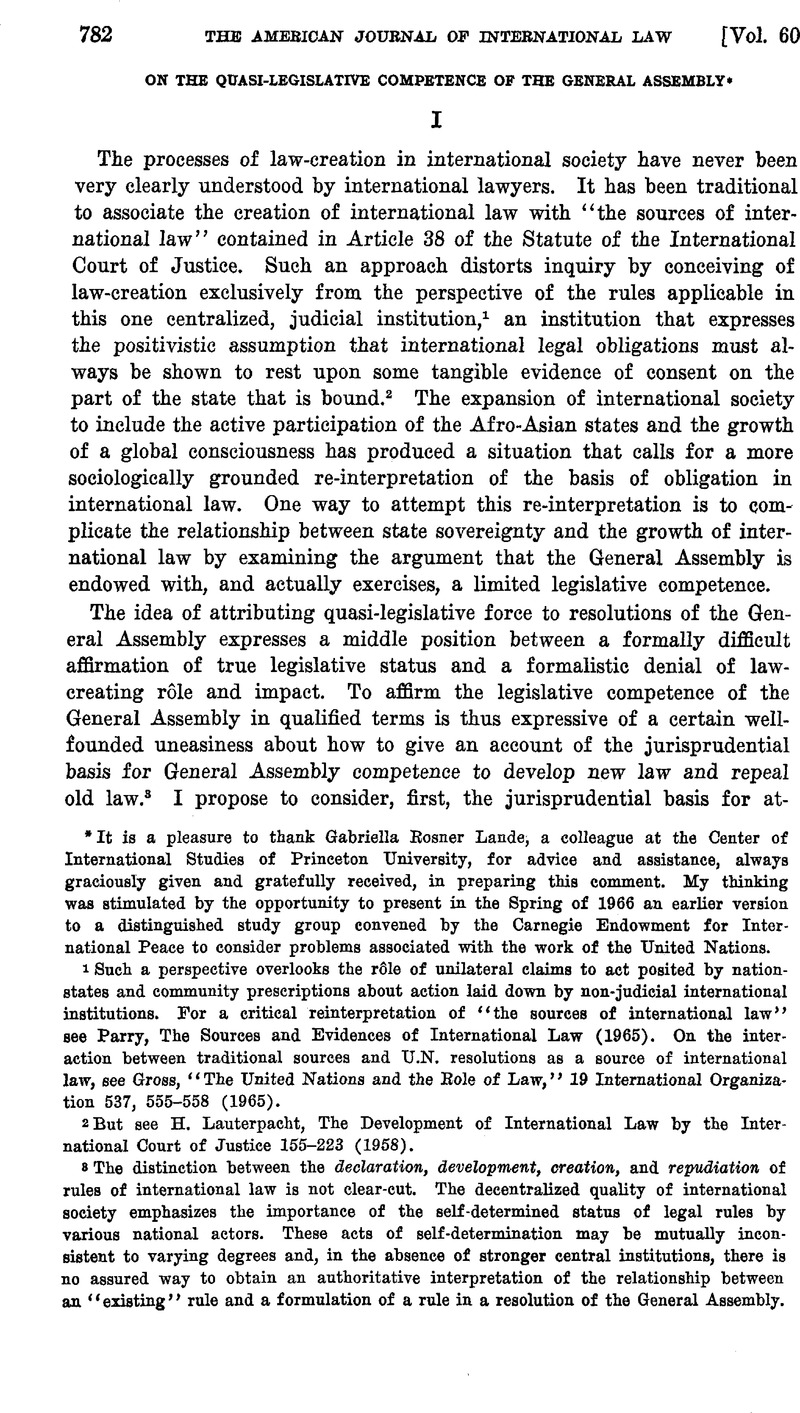Article contents
On the Quasi-Legislative Competence of the General Assembly*
Published online by Cambridge University Press: 28 March 2017
Abstract

- Type
- Editorial Comment
- Information
- Copyright
- Copyright © American Society of International Law 1966
Footnotes
It is a pleasure to thank Gabriella Rosner Lande, a colleague at the Center of International Studies of Princeton University, for advice and assistance, always graciously given and gratefully received, in preparing this comment. My thinking was stimulated by the opportunity to present in the Spring of 1966 an earlier version to a distinguished study group convened by the Carnegie Endowment for International Peace to consider problems associated with the work of the United Nations.
References
1 Such a perspective overlooks the rôle of unilateral claims to act posited by nationstates and community prescriptions about action laid down by non-judicial international institutions. For a critical reinterpretation of “the sources of international law” see Parry, The Sources and Evidences of International Law (1965). On the interaction between traditional sources and U.N. resolutions as a source of international law, see Gross, , ‘ ‘ The United Nations and the Role of Law,'’ 19 International Organization 537, 555-558 (1965)Google Scholar.
2 But see H. Lauterpacht, The Development of International Law by the International Court of Justice 155-223 (1958).
3 The distinction between the declaration, development, creation, and repudiation of rules of international law is not clear-cut. The decentralized quality of international society emphasizes the importance of the self-determined status of legal rules by various national actors. These acts of self-determination may be mutually inconsistent to varying degrees and, in the absence of stronger central institutions, there is no assured way to obtain an authoritative interpretation of the relationship between an “ existing” rule and a formulation of a rule in a resolution of the General Assembly.
4 9 UNCIO Docs. 316 (1945).
5 Ibid. 70.
6 J.S. De Yturriaga, “ Non-Self -Governing Territories,” 1964 Yearbook of World Affairs 178-212, esp. 209-212. For general treatment of these issues see selections, citations, and comments in Falk and Mendlovitz (eds.), The Strategy of World Order, Vol. 3: The United Nations, pp. 37-122, 227-248 (1966).
7 By “functional operation as law” is meant a perceptible relevance to expectations about the permissibility of behavior, including a reference to the use of legal rhetoric to protest a violation of these expectations.
8 For the text of the Shimoda decision, see the Japanese Annual of International Law, 1964, pp. 212-252; for an interpretation, see Fait, , “The Shimoda Case,” 59 A.J.I.L. 759 (1965)Google Scholar.
9 Loc. cit. at 241-242.
10 See, e.g., Arthur Dean's testimony before the Senate Foreign Relations Committee, Hearings, Nuclear Test Ban, Exec. M, 88th Cong., 1st Sess., pp. 824-825, August, 1963.
11 See citations in note 4.
12 C. W. Jenks, Law, Welfare and Freedom 83-100 (1963).
13 See, e.g., Brierly, The Basis of Obligation in International Law 1-62 (1958).
14 P.C.I.J., Ser. A, No. 10, p. 19 (1927).
15 This argument is central to the presentation in Falk, and Mendlovitz, , ‘ ‘ Towards a Warless World: One Legal Formula to Active Transition,” 73 Tale Law J. 399 (1964).Google Scholar
16 Banco National de Cuba v. Sabbatino, 376 U.S. 398, 58 A.J.I.L. 779 (1964); for interpretation, see Falk, “The Complexity of Sabbatino,” 58 A.J.I.L. 935 (1964).
17 It must be noted, however, that the validity of these traditional rules has been rehabilitated, at least within the confines of the United States, by legislative action. Foreign Assistance Act of 1964, §301 (d) (4), 78 Stat 1013, 22 U.S.C. §2370 (e) (2) (1964), 59 A.J.I.L. 368 (1965); see also Cardozo, “Congress vs. Sabbatino: Constitutional Considerations,” 4 Columbia Journal of Transnational Law 297 (1966).
18 P. 5 (1963).
19 U.N. General Assembly Res. 1653 (XVI), Nov. 28, 1961.
20 The continuing reality of intense conflict between the United States and the Soviet Union in the Cold War is now subject to debate. The point remains, however, that a policy disagreement among the super-Powers prevents the assertion by the organs of the United Nations of effective claims to control international behavior.
21 U.N General Assembly Res. 1803 (XVII), Dec. 14, 1962.
22 Cf., e.g., A. S. Fisher, , “Arms Control and Disarmament in International Law,” 50 Virginia Law Review 1200 (1964).Google Scholar
23 J. C. Cooper, , “The Manned Orbiting Laboratory: A Major Legal and Political Decision,” 51 American Bar Association Journal 1137 (1965).Google Scholar
24 Judgment in South West Africa Cases, July 18, 1966, [1966] I.C.J. Rep. 6.
25 McDougal and Burke, The Public Order of the Oceans (1962).
- 23
- Cited by


